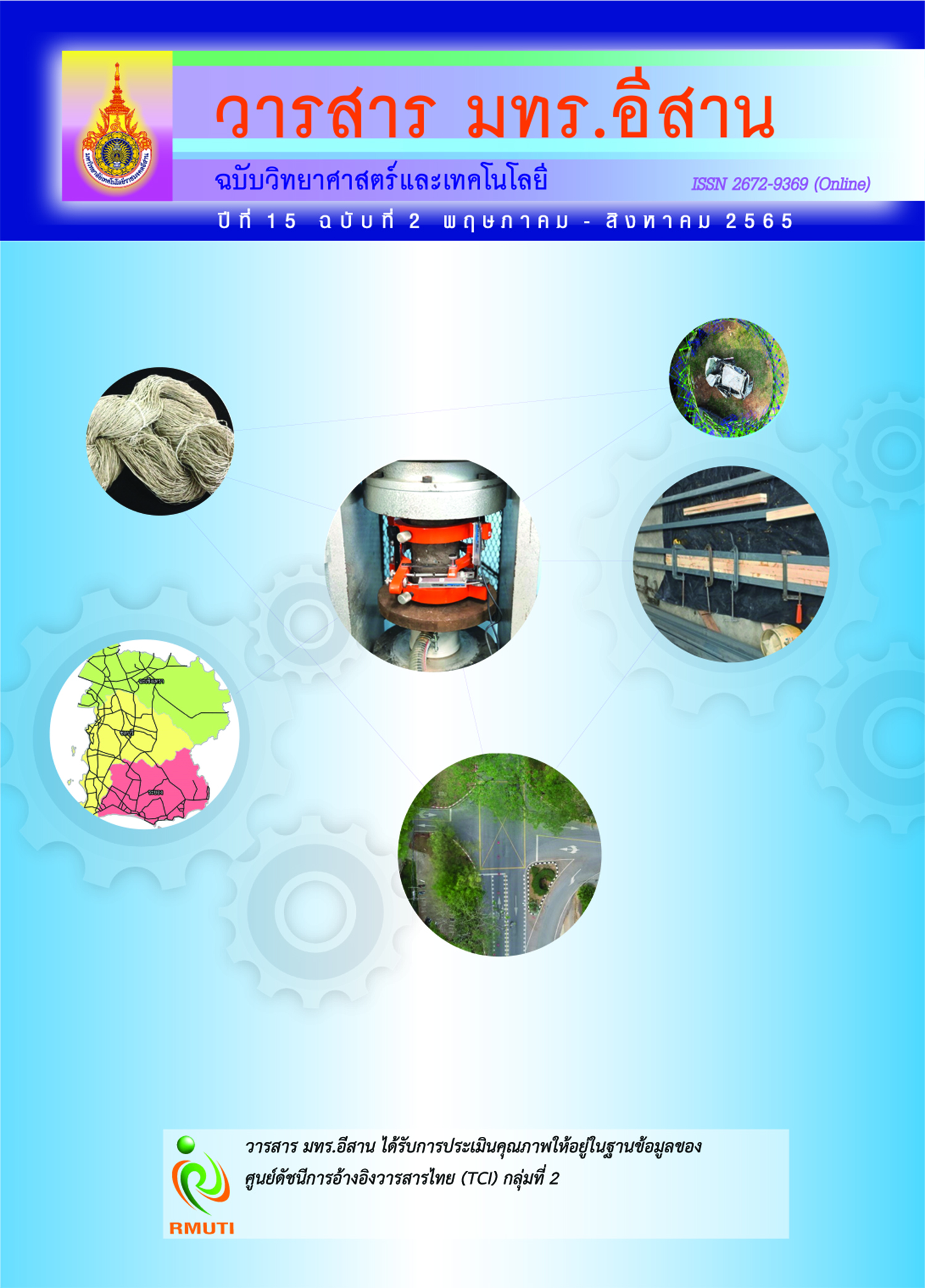Mechanical Properties of Fly Ash Geopolymer Concrete Incorporating Clay Residue and Silica Fume
Main Article Content
Abstract
The purpose of this paper was to investigate the mechanical properties of fly ash (FA) geopolymer concrete incorporating clay residue (CR), and silica fume (SF). The FA: CR: SF ratios were 100:0:0, 90:10:0, 90:5:5, 80:20:0, 80:15:5, 80:10:10, 70:30:0, 70:25:5, 70:20:10, and 70:15:15, respectively. Alkaline solutions of sodium silicate and 10 molar sodium hydroxide were employed as activators. The setting time, compressive strength, elasticity modulus, and Poisson's ratio of FA geopolymer concrete were studied. According to the test results, replacing CR for FA in the production of FA geopolymer concrete could result in a delay in its setting time. Compressive strength and elastic modulus of FA geopolymer concrete decreased with an increase in both CR and SF. It can be concluded that FA geopolymer concrete with 10 % CR did not negatively affect the compressive strength.
Article Details

This work is licensed under a Creative Commons Attribution-NonCommercial-NoDerivatives 4.0 International License.
References
Davidovits, J. (1991). Geopolymers: Inorganic Polymeric New Materials. Journal of Thermal Analysis. Vol. 37, pp. 1633-1656. DOI: 10.1007/BF01912193
Chindaprasirt, P. and Rattanasak, U. (2010). Utilization of Blended Fluidized Bed Combustion (FBC) Ash and Pulverized Coal Combustion (PCC) Fly Ash in Geopolymer. Waste Management. Vol. 30, Issue 4, pp. 667-672. DOI: 10.1016/j.wasman.2009.09.040
Pangdaeng, S., Phoo-ngernkham, T., Sata, V., and Chindaprasirt, P. (2014). Influence of Curing Conditions on Properties of High Calcium Fly Ash Geopolymer Containing Portland Cement as Additive. Materials and Design. Vol. 53, pp. 269-274. DOI: 10.1016/j.matdes.2013.07.018
Abrams, D. A. (1918). Design of Concrete Mixtures. Lewis Institute, Chicago
Chindaprasirt, P. and Jaturapitakkul, C. (2012). Cement Pozzolan and Concrete. Thailand Concrete Association, Bangkok
Thumrongvut, J., Seangatith, S., and Kumlue, K. (2013). Tests on Structural Behaviors of Precast Partially-Prestressed Concrete Beam's Joints. RMUTI JOURNAL. Vol. 6, No. 2, pp. 15-30. (in Thai)
ASTM C618-15. (2015). Standard Specification for Coal Fly Ash and Raw or Calcined Natural Pozzolan for Use in Concrete. Annual Book of ASTM Standard.Vol.04.02.
ASTM C39. (2001). Standard Test Method for Compressive Strength of Cylindrical Concrete Specimens. Annual Book of ASTM Standard. Vol.04.02.
ASTM C469. (2002). Standard Test Method for Static Modulus of Elasticity and Poisson's Ratio of Concrete in Compression. Annual Book of ASTM Standard. Vol.02.01.
Chindaprasirt, P., De Silva, P., Sagoe-Crenstil, K., and Hanjitsuwan, S. (2012). Effect of SiO2 and Al2O3 on the Setting and Hardening of High Calcium Fly Ash-Based Geopolymer Systems. Journal of Materials Science. Vol. 47, No. 12, pp. 4876-4883.
DOI: 10.1007/s10853-012-6353-y
Kroehong, W., Sinsiri, T., Jaturapitakkul, C., and Chindaprasirt, P. (2011). Effect of Palm Oil Fuel Ash Fineness on the Microstructure of Blended Cement Paste. Construction and Building Materials. Vol. 25, Issue 11, pp. 4095-4104. DOI: 10.1016/j.conbuildmat.2011.04.062
Sofi, M., van Deventer, J. S. J., Mendis, P. A., and Lukey, G. C. (2007). Engineering Properties of Inorganic Polymer Concretes (IPCs). Cement and Concrete Research. Vol. 37, Issue 2, pp. 251-257. DOI: 10.1016/j.cemconres.2006.10.008
Phoo-ngernkham, T., Phiangphimai, C., Damrongwiriyanupap, N., Hanjitsuwan, S., Thumrongvut, J., and Chindaprasirt, P. (2018). A Mix Design Procedure for Alkali-Activated High-Calcium Fly Ash Concrete Cured at Ambient Temperature. Advances in Materials Science and Engineering. Vol. 2018, pp. 1-13. DOI: 10.1155/2018/2460403


